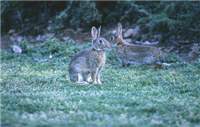Family
LagomorphaGenus
Oryctolagus
Species
cuniculus
Threats/Control Methods - Regional
Numerous predators threaten young rabbits, and more than 80 percent of animals die before the age of three months. Rabbits are also infected by several species of fleas and mites. However, this species is still very abundant, leading to the extinction of many small Australian native plant and animal species. The biological control methods that once destroyed over 90 percent of the Rabbit population are now much less effective and are used in conjunction with traditional control methods of shooting, rabbit-proof fencing, trapping and poisoning.
Threats/Control Methods - Local
Local/Urban Actions
Currently, no control methods are being used in the ACT, as it is not considered enough of a threat.
Common name/s
European Wild Rabbit, Rabbit, Bunny
Distinguishing Features
This well-known species is shorthaired with light grey or brown fur colouring. Adults are between 30 and 40cm in size.
Similar Species
Hares (Lepus Europaeus) are larger and much less common.
Distribution
Wild Rabbits are very abundant in all areas of
Country of Origin
Europe. Rabbits were bought to
Survey Techniques
Rabbits were identified during searches during both the day and night, finding traces from burrows and scats.
Conservation (Pet/Pest) Status - National
Introduced Pest. Competition and land degradation by feral rabbits is listed as a key threatening process under the EPBC Act 1999. It is one of the most abundant animals in Australia, causing severe damage to both the natural environment and to agriculture.
Conservation (Pet/Pest) Status - Regional
LSCCES Population
This species was found in high numbers across the Lower Sullivans Creek Catchment.
Associated vegetation community
Rabbits are well adapted to a wide range of habitats, from deserts to coastal plains. They thrive particularly well where soils are deep and sandy and green grass and herbage is readily available.
Limiting Resources
As long as suitable soil is available to dig warrens (rabbit holes), rabbits can live in extremely harsh environments. They do not depend on access to a water body if they can eat high moisture vegetation. They can eat a wide range of food species in response to scarcity and are only substantially limited by human control methods.
Breeding
The life cycle of rabbits provides a strong clue as to why they have become such a pest in Australia. They can breed when they are only four months old and a female rabbit can be continuously pregnant for 6-8 months of the year. They can produce up to five litters a year with up to seven young each litter. Because of this high reproductive potential a single pair of rabbits can produce up to forty offspring each year. The gestation period is about 30 days. One or two days before rabbits are born, the female constructs a small nest-like burrow lined with grass and fur. Young emerge from the burrow after 21 days.
Behaviour
This is a burrowing species, spending time in large social groups. During the breeding season, rabbits form territorial groups made up of one to three males with up to seven females, led by a dominant pair. After breeding, the groups break up again.
Functional Group
Food Species
In favourable conditions, rabbits prefer green grass and herbs and are nocturnal grazers. They can also dig below grasses to reach roots and seeds and can eat a wide range of food if resources are scarce due to drought bush fire events. Under these conditions they can ringbark trees and shrubs, and prevent regeneration by eating seeds and seedlings.
Predators
Foxes (Vulpes vulpes ), Cats (Felis catus ) and Dingoes (Canis lupus) predate rabbits. Humans are responsible for wide scale eradication projects, especially the release of the biological control Myxomatosis.
Interesting Fact
Rabbits have a special feature of their digestive process, called coprophagy. This allows the rabbit to eat a special pellet of their own poo, containing nutrients and B-group vitamins.
References - (reader suitability of references, P=Primary teachers, S=Secondary students, T=Tertiary students and researchers)
Books:Straham, R. 1983. The Australian Museum Complete Book of Australian Mammals. The National Photographic Index of Australian Wildlife. Angus and Robertson Publishers. Sydney. P, S, T
Online Publications:Department of the Environment and Heritage. 2004. European wild rabbit (Oryctolagus cuniculus). Australian Government. http://www.environment.gov.au/biodiversity/invasive/publications/rabbit/index.html P, S, T
Tidemann, C., Roscoe, T. and Mitchell, B. 2006. Mammals of the Lower Sullivans Creek Catchment, Canberra ACT. Prepared for the Life in the Suburbs project using data from the Lower Sullivans Creek Catchment Ecological Survey (LSCCES). Australian National University. Canberra. [online]. Available at: http://www.lifeinthesuburbs.com.au/category.php?id=65 S, T


 Top
Top Top
Top